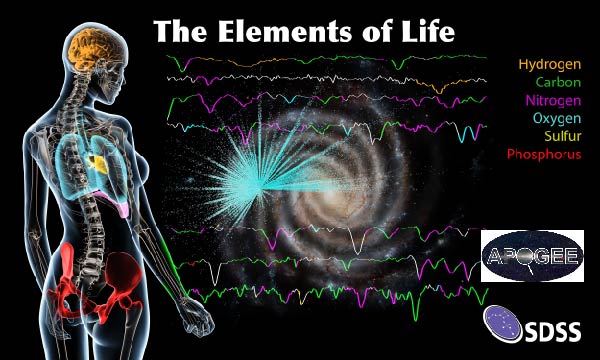The Elements of Life Mapped Across the Milky Way by SDSS/APOGEE | SDSS | Press Releases
http://www.sdss.org/press-releases/the-elements-of-life-mapped-across-the-milky-way-by-sdssapogee/
“For the first time, we can now study the distribution of elements across our Galaxy,” says Sten Hasselquist of New Mexico State University.
“The elements we measure include the atoms that make up 97% of the mass of the human body.”
The new results come from a catalog of more than 150,000 stars; for each star, it includes the amount of each of almost two dozen chemical elements.
The new catalog includes all of the so-called “CHNOPS elements” – carbon, hydrogen, nitrogen, oxygen, phosphorous, and sulfur – known to be the building
blocks of all life on Earth. This is the first time that measurements of all of the CHNOPS elements have been made for such a large number of stars.
How do we know how much of each element a star contains? Of course, astronomers cannot visit stars to spoon up a sample of what they’re made of, so they
instead use a technique called spectroscopy to make these measurements. This technique splits light – in this case, light from distant stars – into detailed
rainbows (called spectra). We can work out how much of each element a star contains by measuring the depths of the dark and bright patches in the spectra
caused by different elements.
Astronomers in the Sloan Digital Sky Survey have made these observations using the APOGEE (Apache Point Observatory Galactic Evolution Experiment) spectrograph
on the 2.5m Sloan Foundation Telescope at Apache Point Observatory in New Mexico. This instrument collects light in the near-infrared part of the electromagnetic
spectrum and disperses it, like a prism, to reveal signatures of different elements in the atmospheres of stars. A fraction of the almost 200,000 stars surveyed
by APOGEE overlap with the sample of stars targeted by the NASA Kepler mission, which was designed to find potentially Earth-like planets. The work presented
today focuses on ninety Kepler stars that show evidence of hosting rocky planets, and which have also been surveyed by APOGEE.
